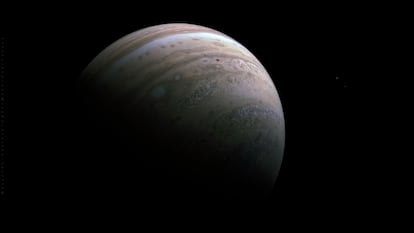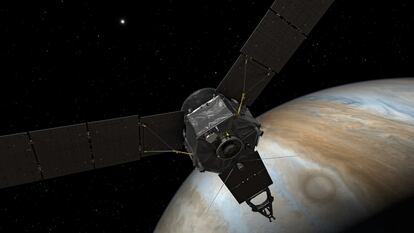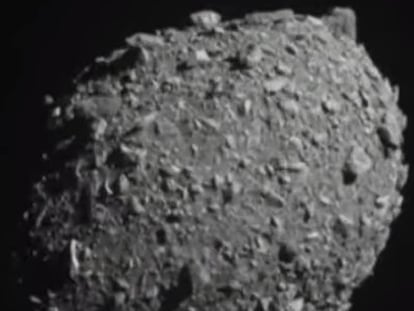Juno spacecraft to fly by Jupiter’s icy moon Europa
The NASA probe will photograph the satellite, which researchers believe could be capable of supporting life

Jupiter’s icy moon Europa is about to receive a new visit from Earth. NASA’s spacecraft Juno, which has been orbiting the gigantic planet since July 2016, will perform a close flyby on Thursday at 5.36am EDT (9.36 UCT). The last time a spacecraft visited Europa was 22 years ago, when NASA’s Galileo spacecraft captured a series of images of the moon.
The Juno spacecraft has been orbiting Jupiter in elongated loops, which reach distances of more than three million miles (five million kilometers) at the farthest point before falling to less than 3,100 miles (5,000 km) at the perijove, the point in the orbit at which Juno is nearest to Jupiter. While flying at the highest points, Juno moves somewhat slowly, but its passage through the perijove is lightning-fast: 37 miles (60 km) per second. This orbit, which passes over Jupiter’s poles, was designed to minimize the damage to Juno from passing through the belts of trapped radiation.
Indeed, in 2003, one of the data recorders on the Galileo spacecraft was damaged, leaving it inactive for weeks until technicians were able to repair it remotely. The Galileo, however, followed a smaller equatorial orbit, meaning it was exposed to higher doses of radiation. Juno, on the other hand, has a wider orbit and its most sensitive instruments are enclosed in a kind of safe with centimeter-thick titanium walls. Without this protection, the on-board electronics would have been “fried” in the first orbit around Jupiter.
Juno’s mission was only to study Jupiter. Its trajectory was not calculated to approach any of the planet’s 79 moons. And only very occasionally has the spacecraft neared one. The most spectacular occasion was in June 2021, when it passed just over 600 miles (1,000 km) above Ganymede, Jupiter’s largest moon. As it was a very brief flyby, the probe was only able to capture a few images, albeit of great quality.

The flyby over Europa, which was discovered by astronomer Galileo Galilei in 1610, will also last only a few minutes. The probe will come within 222 miles (350 km) of the surface of Jupiter’s ice-covered moon, which will allow it to capture much more detailed images than those that currently exist. The angle of the flyby also means that June will see regions that aren’t clearly visible in previous photos of the moon. The on-board camera – designed initially to study Jupiter – will take several images as it flies over the illuminated hemisphere. When it crosses into the dark hemisphere, Juno will take just one photo, using its stellar sensor, which is adapted to the dim glow of stars. In the middle of the night, the illumination will come from the reflection of the Sun in the clouds of Jupiter.
Europe is a frozen world, which some have compared to a cosmic billiard ball. It is believed with some certainty that its miles-thick ice shell hides an ocean that could be capable of supporting life. Its snow-white surface contains many dark grooves, which may be rocky material coming up from deeper layers. Other regions appear to contain huge tabular icebergs – as if the frozen layer had partially melted and then refroze, trapping the floating ice blocks in a poorly assembled puzzle.
There are signs that Europa, like Enceladus, the sixth-largest moon of Saturn, emits jets of water from cracks in the ice. This phenomenon has been photographed in detail on Enceladus, but there is no firm evidence of it on Europa. Finding signs of water jets will be one of the goals of NASA’s Europa Clipper probe, scheduled for launch in 2024.
Juno’s flyby over Europa will take place during the spacecraft’s 45th orbit around Jupiter. In February 2024, June will also perform a close flyby of Jupiter’s moon Io, which is home to 400 volcanoes. The flyby will take place in Juno’s 58th orbit for the planet, a feat of survival in an environment as hostile as the one the spacecraft is facing.
Tu suscripción se está usando en otro dispositivo
¿Quieres añadir otro usuario a tu suscripción?
Si continúas leyendo en este dispositivo, no se podrá leer en el otro.
FlechaTu suscripción se está usando en otro dispositivo y solo puedes acceder a EL PAÍS desde un dispositivo a la vez.
Si quieres compartir tu cuenta, cambia tu suscripción a la modalidad Premium, así podrás añadir otro usuario. Cada uno accederá con su propia cuenta de email, lo que os permitirá personalizar vuestra experiencia en EL PAÍS.
¿Tienes una suscripción de empresa? Accede aquí para contratar más cuentas.
En el caso de no saber quién está usando tu cuenta, te recomendamos cambiar tu contraseña aquí.
Si decides continuar compartiendo tu cuenta, este mensaje se mostrará en tu dispositivo y en el de la otra persona que está usando tu cuenta de forma indefinida, afectando a tu experiencia de lectura. Puedes consultar aquí los términos y condiciones de la suscripción digital.
More information
Últimas noticias
Most viewed
- David King, chemist: ‘There are scientists studying how to cool the planet; nobody should stop these experiments from happening’
- Reinhard Genzel, Nobel laureate in physics: ‘One-minute videos will never give you the truth’
- Mexico completes its trade shift with the entry into force of tariffs on China and countries without trade agreements
- Oona Chaplin: ‘I told James Cameron that I was living in a treehouse and starting a permaculture project with a friend’
- Sinaloa Cartel war is taking its toll on Los Chapitos











































